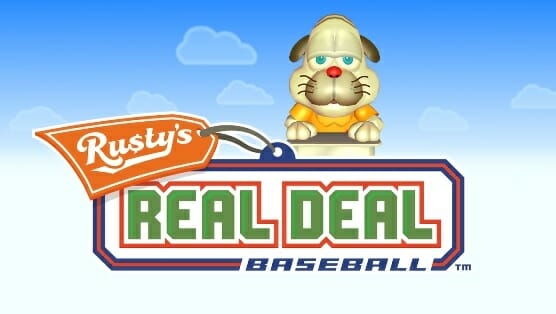
Rusty Slugger is probably the best original Nintendo character in decades. While a quirky talking dog might seem familiar to Animal Crossing fans, they’ve never encountered one quite like the star of Rusty’s Real Deal Baseball, now free on the 3DS eShop. What makes this washed-up, middle-aged, former baseball player so compelling is that beneath his comic mishaps and jovial self-deprecation there’s a shockingly frank sense of tragedy to his tales of domestic woe. As he peddles his baseball wares, there’s a real chance players might become more invested in a cartoon dog’s failing marriage than in practicing their batting or calling balls and strikes.
It’s fitting then that a character defined by desperation headlines Nintendo’s second recent stab at a free-to-play game, a market the vulnerable company desperately needs to understand to stave off mobile game oblivion. However, while the unspectacular Steel Diver: Sub Wars just borrowed the common free demo/premium upgrade monetization system, Rusty’s Real Deal Baseball succeeds because it is a thoroughly Nintendo take on the F2P model. In fact, its biggest issue is that these fascinating fringe elements, like the in-game purchase system and dark, bordering on inappropriate characterization, are ultimately more engaging then the ten baseball minigames which are the ostensible point of the package.
From batting cage drills to catcher’s training, these “Nontendo 4DS” activities have players learning a variety of baseball skills while never actually playing a full game of baseball. These diverse tasks also use diverse controls. Timing a button press to swing a bat is pretty obvious and straightforward. But snagging a pop fly by tilting up the handheld or bouncing it up and down to juggle balls in the air gives the system’s alternative input methods some much needed love. Using the touch screen, players can even carve their own bat and step up to the plate holding the thinning rod or a raw log of wood.
Not every game is a home run though. Too many are just mild variations on the same catching and batting themes. Each features an endless arcade mode and a harder secondary mode that are unlocked after clearing so many stages. But the 25 initial levels that make up each bite-sized activity quickly get repetitive over extended sessions. Also, while the game’s visual style sports some truly bizarre Japanese touches, like businessmen with ball dispensers for heads, the overall aesthetic is the same, generic look of most Nintendo games that star Miis, like Wii Sports and Pilotwings Resort.
The real fun of Rusty’s Real Deal Baseball comes from how the games are actually acquired. Each starts at $4, but players can start haggling with Rusty by buttering him up with donuts earned by playing. The game then drastically morphs into something Telltale might have produced. Players must first listen to Rusty’s hilariously pathetic and extremely well-localized dialogue. They then respond with the right answer, be it an item like a new toupee or a friendly piece of advice, to encourage him to slash the price. Initially, savings top out around 50%, but as players purchase more games and advance through the six-part story, the final haggle brings the price all the way down to a buck. Rusty makes customers work for those kinds of savings though. The last session plays out almost like a haggling boss fight. Smart shoppers can also lower prices using discount cards earned by playing, but while combining them effectively takes skill as well, they’re much less engaging than the haggling mechanic. By turning saving money into a gameplay incentive, the game makes the final decision to accept the new cheaper price as satisfying as stabbing Ganondorf at the end of a Zelda game. Except this time the Master Sword is a MasterCard.
By crafting a F2P system that’s more concerned with fun than exploitation, Nintendo has created a great, original take on the concept. Instead of offering $100 energy packs that get burned through in minutes, the game presents a finite amount of content upfront with clearly defined upper and lower price limits. The savviest players can bring the total price down to $16, but the whole thing only costs $40 at most. Early on, players also adopt one of Rusty’s identical ten children with names like Russ Tee, Rustanee and Rustin (Cohle?) During haggling sessions, these sidekicks actively encourage players to save as much as possible by congratulating them when they’ve reached the maximum or scolding them when they haven’t pushed far enough. From a business perspective it seems crazy, and maybe that’s why Rusty is so strapped for cash, but it makes the player feel like a respected, valued customer instead of a rube waiting to be suckered. This then encourages them to stay loyal and keep spending.
When Nintendo has confronted genres that made them uncomfortable in the past, they’ve always been able to come up with fresh reinventions. Consider Pikmin and Super Smash Bros, radical spins on real-time strategy and fighting games, respectively. But with Rusty’s Real Deal Baseball, they’ve applied the same philosophy to an entire business model that they, along with many players, are actually right to be wary of. The result is a F2P system that’s completely new, refreshingly ethical, and surprisingly fun in its own right. Now they just need to unleash it on something other than a spotty collection of baseball minigames.
Rusty’s Real Deal Baseball was designed and published by Nintendo. It is available for the 3DS and the 2DS.
Jordan Minor is a freelance writer who can’t wait to use his fancy Northwestern University journalism degree to mostly write about videogames. Follow him on Twitter @JordanWMinor.
